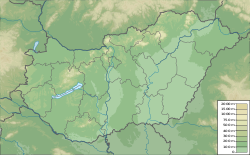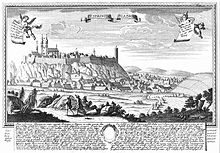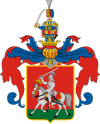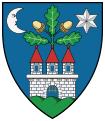Veszprém
Veszprém Vesprim (in Latin) Wesprim / Weißbrunn (in German) Vesprim (in Croatian) Vesprím / Besprim (in Slovak) (in Czech) Belomost (in Slovene) | ||
|---|---|---|
City with county rights | ||
| Veszprém Megyei Jogú Város | ||
     From top, left to right: Castle Hill, County Library, Statue of King Stephen I. and Queen Gisela, Fire-watch Tower, Veszprém Cathedral and Castle Gate | ||
| ||
| Nickname(s): City of Queens | ||
 Veszprém Location of Veszprém Show map of Hungary  Veszprém Veszprém (Europe) Show map of Europe | ||
| Coordinates: 47°05′35″N 17°54′50″E / 47.09296°N 17.91377°E / 47.09296; 17.91377Coordinates: 47°05′35″N 17°54′50″E / 47.09296°N 17.91377°E / 47.09296; 17.91377 | ||
| Country | ||
| Region | Central Transdanubia | |
| County | Veszprém | |
| District | Veszprém | |
| Established | 9th century AD | |
| City status | 1870 | |
| Government | ||
| • Mayor | Gyula Porga (Fidesz-KDNP) |
|
| • Deputy Mayor |
List[2]
|
|
| • Town Notary |
Dr Gábor Mohos | |
| Area | ||
| • City with county rights |
126.93 km2 (49.01 sq mi) | |
| Elevation |
266 m (873 ft) | |
| Population (January 1, 2017) | ||
| • City with county rights |
56,927[1] |
|
| • Rank | 16th | |
| • Density | 448.49/km2 (1,161.6/sq mi) | |
| • Urban |
133,880 (13th)[3] |
|
| Demonym(s) | veszprémi | |
Population by ethnicity [4] | ||
| • Hungarians |
83.9% | |
| • Germans |
2.4% | |
| • Gypsies |
0.7% | |
| • Romanians |
0.1% | |
| • Serbs |
0.1% | |
| • Slovaks |
0.1% | |
| • Armenians |
0.1% | |
| • Bulgarians |
0.1% | |
| • Polish |
0.1% | |
| • Ukrainians |
0.1% | |
Population by religion [5] | ||
| • Roman Catholic |
38.9% | |
| • Greek Catholic |
0.3% | |
| • Calvinists |
7.0% | |
| • Lutherans |
2.1% | |
| • Other | 1.4% | |
| • Non-religious |
20.6% | |
| • Unknown | 29.6% | |
| Time zone | UTC+1 (CET) |
|
| • Summer (DST) | UTC+2 (CEST) |
|
| Postal code | 8200 |
|
| Area code | (+36) 88 | |
| Motorways | M8 Motorway (planned) |
|
| NUTS 3 code | HU213 | |
| Distance from Budapest | 109 km (68 mi) Northeast | |
| Airport | Veszprém | |
| MP | Péter Ovádi (Fidesz) |
|
| Website | www.veszprem.hu | |
Veszprém (Hungarian pronunciation: [ˈvɛspreːm]; German: Weißbrunn, Slovene: Belomost) is one of the oldest urban areas in Hungary, and a city with county rights. It lies approximately 15 km (9 mi) north of the Lake Balaton. It is the administrative center of the county (comitatus or 'megye') of the same name.
Contents
1 Etymology
2 Location and legend
3 History
4 Economy
5 Demographics
6 Notable citizens
7 International relations
7.1 Twin towns — Sister cities
8 Tourism
9 Gallery
10 References
11 External links
Etymology
The name of the city originates from a Slavic personal name Bezprem or Bezprym (Proto-Slavic Bezprěmъ) meaning "stubborn", "self-confident, not willing to retreat".[6]Besprem (before 1002), Vezprem (1086), Bezpremensis (1109).[6] The form Vezprem originates in early medieval scribal habits and frequent exchange of B and V under the influence of Greek.[6]
The city was named either after a chieftain, or the son of Princess Judith (elder sister of St. Stephen of Hungary), who settled here after her husband Boleslaus I of Poland expelled her and her son.[citation needed]
Location and legend
Veszprém lies on both sides of the Séd creek, approximately 110 km (68 mi) from Budapest (via the M7 highway and Road 8). It can also be reached from Győr via Road 82 and from Székesfehérvár via Road 8.
According to legend, Veszprém was founded on seven hills. The seven hills are Várhegy (Castle Hill), Benedek-hegy (St. Benedict Hill), Jeruzsálem-hegy (Jerusalem Hill), Temetőhegy (Cemetery Hill), Gulyadomb (Herd Hill), Kálvária-domb (Calvary Hill), and Cserhát.
History


Veszprém in the Kingdom of Hungary in 1913
Anonymus Belæ Regis Notarius (the anonymous notary of King Béla III) wrote that a castle already stood here when the Hungarians first occupied the area. The castle was probably a 9th-century Frankish fortress. The castles of Veszprém, Esztergom and Székesfehérvár, were the earliest Hungarian stone castles, which had already been built during the reign of High Prince Géza, a time when motte castles were much more common.
Veszprém had an important religious role during the struggle to make Christianity the official religion of Hungary - Stephen I of Hungary defeated the armies of his chief opponent, Koppány, near Veszprém. The city became the first episcopal seat of Hungary in 1009 and an archiepiscopal seat in 1993. Comitatus Veszprém was one of the earliest historical counties of Hungary.
During the 13th century Mongol invasion of Hungary, Veszprém was protected by its castle.[7]
Veszprém was the favorite city of Queen Gisela, the wife of St. Stephen. For centuries, the queens of Hungary were crowned by the bishop of Veszprém. The city is still often called "the city of queens". In the year 1294 Queen Fenenna confirmed that, at that time, the former(!) Queen Elizabeth had the privilege to collect the donations of the church in the Veszprém County.
Veszprém was among the first Hungarian cities to have a university - students studied law and arts here for several centuries. The university was destroyed by fire in 1276, when Peter I Csák invaded and devastated the Diocese of Veszprém. Veszprém became a university town again in the 20th century.
Veszprém changed hands between Austrians and Ottomans until 1684 after the Battle of Mohács in 1526. It was known as "Pespirim" and was a sanjak centre in Budin Province during Ottoman rule.[citation needed]
The town was plundered by the Turks in 1552,[8] but they could not maintain occupation: the region north of lake Balaton remained in the Kingdom of Hungary (1538–1867) (captaincy between Balaton and Drava). The castle was demolished in 1706. Until 1918, VESZPRIM (also named WESZPRIM and WESPRIM near 1850, and WEISSBRUNN in German) was part of the Austrian monarchy, province of Hungary;[9] in Transleithania after the compromise of 1867 in the Kingdom of Hungary.
During World War II, Veszprém was captured by Soviet troops of the 3rd Ukrainian Front on 23 March 1945 in the course of the Vienna Offensive.

The Holy Trinity Square behind Veszprém Cathedral in the Castle Hill

Economy
The Hungarian automotive plastic spare parts manufacturer Videoton Plastic[10] (part of Videoton), the Hungarian kiosk manufacturer Kiosksystems[11], the Hungarian shutter manufacturer Roll-Lux[12], the Hungarian label manufacturer Imprenta[13], the Hungarian tool manufacturer Solidsteel[14], the Hungarian technical ceramics manufacturer Bakony Ipari Kerámia[15], the Hungarian furniture manufacturer Balaton Bútor[16], the Hungarian machine manufacturer Flexmont[17], the Hungarian watermanagement company PureAqua[18], the Hungarian automotive spare parts manufacturer Win-Pres[19], the Hungarian construction company VEMÉVSZER[20], the Hungarian metal manufacturer Ferro-Trio[21], the Hungarian OOK Printhouse[22], the Hungarian toolmanufacturer Plasticor[23], the Hungarian machine manufacturer Transmoduls[24], the Hungarian Prospektus Printhouse[25] have both their headquarters and main production facilities in Veszprém.
The French pharmaceutical company Citoxlab[26], the Austrian plaster manufacturer Lasselsberger-Knauf[27], the Swiss electric motor manufacturer Maxon Motor[28], the Austrian tile manufacturer Bramac[29], the French automotive spare parts manufacturer Valeo[30], the German electromagnetical controlsystems manufacturer nass magnet[31], the German automotive spare parts manufacturer Continental AG[32], the German automotive spare parts manufacturer Thun[33], the German sensor manufacturer Pepperl+Fuchs[34], the Austrian chimney and ventilation system manufacturer Schiedel[35], the American power supply security company CoreComm[36], the German censor manufacturer Balluff[37], the German automotive spare parts manufacturer Jost[38], the German health devices manufacturer Beurer[39], the British-Dutch food producer Unilever[40] and the Hungarian dairy product manufacturer Pannontej[41] operate production plants in the city.
The Dutch General Logistics Systems[42], the Hungarian Magyar Posta, the German Penny Market[43], the Hungarian Locargo[44] and the Austrian Persped[45] have logistics centres there.
The Hungarian owned Vöröskő electrical retailer (holder of the brand Euronics in Hungary) is also based in the city.
The Veszprém Aréna provides place besides sport events for exhibitions and conferences.[46]
Demographics
| Historical population | ||
|---|---|---|
| Year | Pop. | ±% |
| 1870 | 14,279 | — |
| 1880 | 14,726 | +3.1% |
| 1890 | 14,807 | +0.6% |
| 1900 | 16,223 | +9.6% |
| 1910 | 16,864 | +4.0% |
| 1920 | 17,513 | +3.8% |
| 1930 | 19,991 | +14.1% |
| 1941 | 24,025 | +20.2% |
| 1949 | 20,682 | −13.9% |
| 1960 | 28,222 | +36.5% |
| 1970 | 40,415 | +43.2% |
| 1980 | 57,249 | +41.7% |
| 1990 | 63,867 | +11.6% |
| 2001 | 62,851 | −1.6% |
| 2011 | 61,721 | −1.8% |
| 2018 | 59,732 | −3.2% |
| 2021! | 60,000 | +0.4% |
| 2031! | 58,000 | −3.3% |
| 2041! | 56,000 | −3.4% |
According to the 2011 census beside the 83.9% Hungarian majority the city has a historical German minority numbering 2.4% of the population. The second largest ethnic group is the Roma with 0.7%. The others are all marginal.[47]
The religious affiliation of the citizens has a Catholic majority with 38.9% Roman Catholic and 0.3% Greek Catholic. The Calvinists (7.0%) have the second, the Lutherans (2.1%) the third largest denomination in the city. 20.6% are not religious.[48]
Notable citizens
Péter Andorka (born in 1984), Hungarian footballer
Leopold Auer (1845–1930), violinist, academic, conductor and composer
Marian Cozma (1982–2009), handball player
Tamás Kádár (born 1990), footballer (Dynamo Kyiv)
Attila Mesterházy (born 1974), politician (MSZP)
Tibor Navracsics (born 1966), politician, European Commissioner for Education, Culture, Multilingualism and Youth (2014–present)
Csaba Vastag (born 1982), singer
Tamás Vastag (born 1991), singer
International relations
Twin towns — Sister cities
Veszprém is twinned with:[49]
|
|
Tourism
- Kittenberger Kálmán Zoo & Botanical Garden
Gallery

View of the City

Fire-watch tower

Holy Trinity Column

View from the Castle Hill

Veszprém Cathedral

Castle Hill

Episcopal Palace

City Hall

County Hall

Castle Gate

Holy Trinity Square

Nagypréposti Palace

Library of Veszprém


Gizella Capel (11th century)

Bone of queen Giselle. Kept in a church in Veszprem
Statue of King Stephen I. and Queen Gisela
References
^ [http://nepesseg.com/veszprem/veszprem#3 2017. év: Magyarország állandó lakosságának száma az év első napján (2017. január 1.) XLS táblázat. Nyilvantarto.hu (Hozzáférés: 2017. április 6.)
^ Veszprém - Alpolgármesterek
^ Eurostat, 2016
^ KSH - Veszprém, 2011
^ KSH - Veszprém, 2011
^ abc Krajčovič, Rudolf (2005). Živé kroniky slovenských dejín [Living Chronicles of the Slovak History] (in Slovak). Bratislava: Literárne informačné centrum. p. 61. ISBN 80-88878-99-3..mw-parser-output cite.citation{font-style:inherit}.mw-parser-output q{quotes:"""""""'""'"}.mw-parser-output code.cs1-code{color:inherit;background:inherit;border:inherit;padding:inherit}.mw-parser-output .cs1-lock-free a{background:url("//upload.wikimedia.org/wikipedia/commons/thumb/6/65/Lock-green.svg/9px-Lock-green.svg.png")no-repeat;background-position:right .1em center}.mw-parser-output .cs1-lock-limited a,.mw-parser-output .cs1-lock-registration a{background:url("//upload.wikimedia.org/wikipedia/commons/thumb/d/d6/Lock-gray-alt-2.svg/9px-Lock-gray-alt-2.svg.png")no-repeat;background-position:right .1em center}.mw-parser-output .cs1-lock-subscription a{background:url("//upload.wikimedia.org/wikipedia/commons/thumb/a/aa/Lock-red-alt-2.svg/9px-Lock-red-alt-2.svg.png")no-repeat;background-position:right .1em center}.mw-parser-output .cs1-subscription,.mw-parser-output .cs1-registration{color:#555}.mw-parser-output .cs1-subscription span,.mw-parser-output .cs1-registration span{border-bottom:1px dotted;cursor:help}.mw-parser-output .cs1-hidden-error{display:none;font-size:100%}.mw-parser-output .cs1-visible-error{font-size:100%}.mw-parser-output .cs1-subscription,.mw-parser-output .cs1-registration,.mw-parser-output .cs1-format{font-size:95%}.mw-parser-output .cs1-kern-left,.mw-parser-output .cs1-kern-wl-left{padding-left:0.2em}.mw-parser-output .cs1-kern-right,.mw-parser-output .cs1-kern-wl-right{padding-right:0.2em}
^ There were two 13th century Mongol invasions of Hungary, in 1241-42 and in 1285-86. It is unclear whether Veszprém was attacked during both invasions or only one of them, and when the castle was built. King Béla IV organised the building of many stone fortresses after the first invasion.
^ German Wikipedia.
^ Handbook of Austria and Lombardy-Venetia Cancellations on the Postage Stamp Issues 1850-1864, by Edwin MUELLER, 1961.
^ Videoton plastic
^ Kiosksystems - Cégünkről - Bemutatkozás
^ Roll-Lux - Történetünk
^ Imprenta - Cégtörténet
^ Solidsteel - Főoldal
^ Bakony Ipari Kerámia - veol.hu - HIRDETÉS March 1, 2018
^ Balaton Bútor
^ - Flexmont
^ PureAqua
^ Win-Pres
^ VEMÉVSZER
^ Ferro-Trio
^ OOK Nyomda - Rólunk
^ Plasticor - About Us
^ Transmoduls - About Us
^ Prospektus Nyomda - Company profile - History
^ Citoxlab - Contact Us
^ Lasselsberger-Knauf - Húsz éve nem ugrott ekkorát a veszprémi építőipari gyártó - August 3, 2017
^ Maxon Motors - Production sites
^ Bramac - Rólunk - Cégkrónika
^ Valeo
^ nass magnet
^ - Continental AG - Veszprém
^ Thun - Locations
^ Pepperl-Fuchs
^ Schiedel
^ CoreComm - Cégünkről
^ Balluff]
^ Jost - Vállalat - Cégtörénet
^ Beurer - Company - sites
^ Unilever - Ice Cream Factory
^ Pannontej - Rólunk
^ GLS
^ 59 üzletet szolgál ki új veszprémi logisztikai központjából a Penny Market - October 17, 2017
^ Locargo
^ Persped - Rólunk
^ Veszprém Aréna
^ KSH - Veszprém, 2011
^ KSH - Veszprém, 2011
^ "Nemzetközi kapcsolatok". Retrieved 1 May 2014.
^ Kursk guide
^ "Miasta Partnerskie". Retrieved 1 May 2014.
External links
Wikimedia Commons has media related to: Veszprém (category) |
| Wikivoyage has a travel guide for Veszprém. |
Official site
English pages on official site
Pannon University (formerly University of Veszprém)- Aerial photography: Veszprém
- Veszprém at funiq.hu






















Comments
Post a Comment